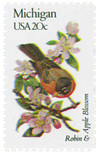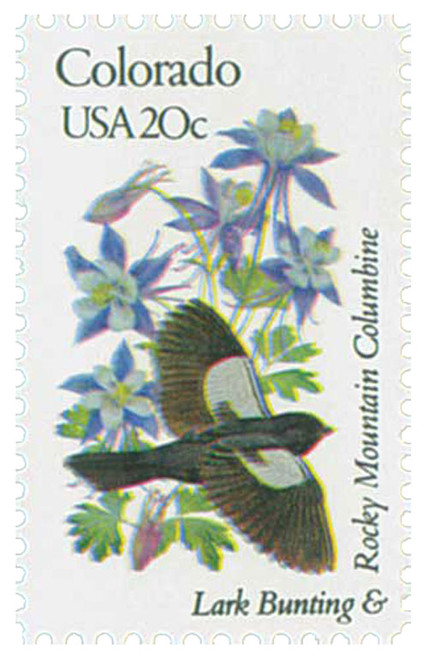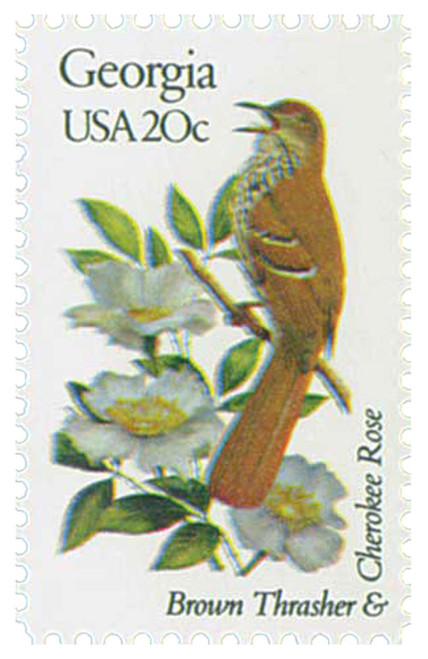
# 1974 - 1982 20c State Birds and Flowers: Michigan
20¢ Michigan
State Birds and Flowers
City: Washington, DC and state capitals
Quantity: 13,339,000 panes
Printed By: Bureau of Engraving and Printing
Printing Method: Photogravure
Perforations: 10.5 x 11.25
Color: Multicolored
Michigan Becomes 26th State
French explorer Étienne Brûlé was likely the first European to visit Michigan when he explored the area around 1620. In 1634, Quebec Governor Samuel de Champlain sent Jean Nicolet to search for a route to the Pacific Ocean. Nicolet sailed through the Straits of Mackinac and explored the Upper Peninsula. In 1660, Father René Ménard established a Jesuit mission at Keweenaw Bay. The first permanent settlement was created by Father Jacques Marquette at Sault Ste. Marie in 1668.
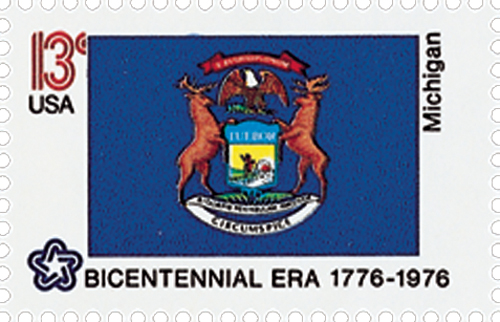
France and Great Britain struggled for control of North America during the late 1600s and 1700s. By 1763, France was defeated and forced to relinquish control of most of its North American colonies. That same year, the Ottawa Indian Chief Pontiac led an uprising and massacred the British at Fort Michilimackinac and attacked several other forts. Pontiac’s forces laid siege to Detroit for five months, but were eventually turned away. In 1774, the British made Michigan a part of the province of Quebec.
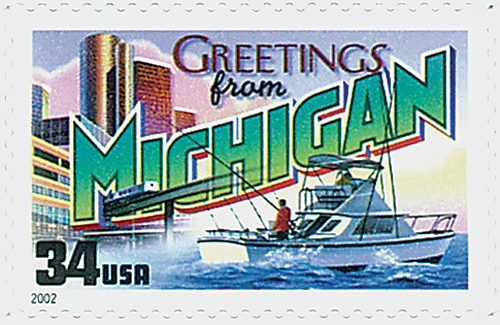
A constitutional convention was held, and on October 5, 1835, the people ratified the state’s constitution. However, Congress delayed Michigan’s admittance to the Union due to a dispute with Ohio over the Toledo area. Congress settled this in 1836 by giving the “Toledo Strip” to Ohio and the entire Upper Peninsula to Michigan. Finally, Michigan became the 26th state to join the Union on January 26, 1837.
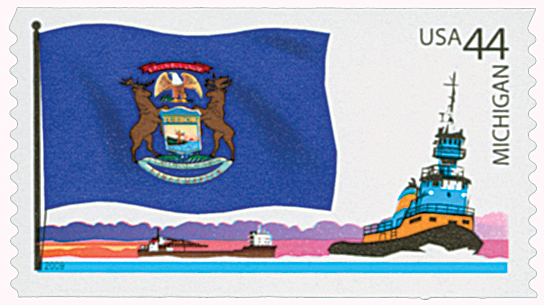
In 1842, Michigan obtained Isle Royale and the Keweenaw Peninsula in a treaty with the Indians. It was discovered that the western portion of the Upper Peninsula was an important source of minerals. The Upper Peninsula quickly developed a thriving mining industry. The need to ship ore to the iron and steel centers on the Great Lakes resulted in the construction of the Soo Canal, which was completed in 1855. The Soo Canal allowed ships to pass between Lake Superior and Lake Huron.
20¢ Michigan
State Birds and Flowers
City: Washington, DC and state capitals
Quantity: 13,339,000 panes
Printed By: Bureau of Engraving and Printing
Printing Method: Photogravure
Perforations: 10.5 x 11.25
Color: Multicolored
Michigan Becomes 26th State
French explorer Étienne Brûlé was likely the first European to visit Michigan when he explored the area around 1620. In 1634, Quebec Governor Samuel de Champlain sent Jean Nicolet to search for a route to the Pacific Ocean. Nicolet sailed through the Straits of Mackinac and explored the Upper Peninsula. In 1660, Father René Ménard established a Jesuit mission at Keweenaw Bay. The first permanent settlement was created by Father Jacques Marquette at Sault Ste. Marie in 1668.

France and Great Britain struggled for control of North America during the late 1600s and 1700s. By 1763, France was defeated and forced to relinquish control of most of its North American colonies. That same year, the Ottawa Indian Chief Pontiac led an uprising and massacred the British at Fort Michilimackinac and attacked several other forts. Pontiac’s forces laid siege to Detroit for five months, but were eventually turned away. In 1774, the British made Michigan a part of the province of Quebec.

A constitutional convention was held, and on October 5, 1835, the people ratified the state’s constitution. However, Congress delayed Michigan’s admittance to the Union due to a dispute with Ohio over the Toledo area. Congress settled this in 1836 by giving the “Toledo Strip” to Ohio and the entire Upper Peninsula to Michigan. Finally, Michigan became the 26th state to join the Union on January 26, 1837.

In 1842, Michigan obtained Isle Royale and the Keweenaw Peninsula in a treaty with the Indians. It was discovered that the western portion of the Upper Peninsula was an important source of minerals. The Upper Peninsula quickly developed a thriving mining industry. The need to ship ore to the iron and steel centers on the Great Lakes resulted in the construction of the Soo Canal, which was completed in 1855. The Soo Canal allowed ships to pass between Lake Superior and Lake Huron.






